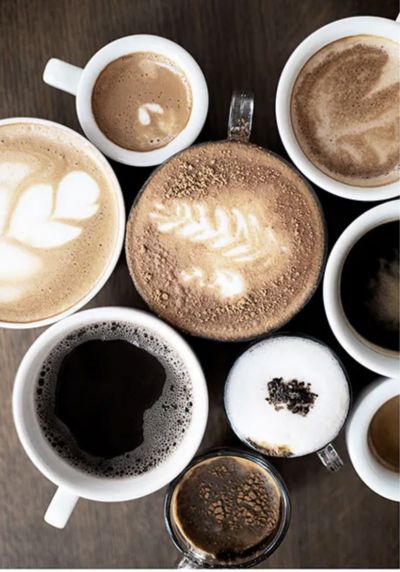Joe, Java, Brew…these are just a few of the names we give to that wonderful cup of coffee. Coffee lovers may be referred to as coffee aficionados, coffee connoisseurs, even coffee snobs! It is a fact that coffee is one of the most popular breakfast drinks in the world, in fact one of the most popular drinks any time of day.
There are many versions of its history and origins, but by the mid-16th century, coffee came to be known as “the wine of Araby” in the Arab world. It became an acceptable and preferred substitute for the forbidden wine of the Muslim religion. Whoever established the first cafe, or coffee house, is also debatable; but these places soon became lively gathering spots wherever they opened.
It seems that coffee was introduced to Europe from travellers returning from the East. The Eastern trade route led to Venice where in 1683 one of the oldest coffee houses was established in the Procuratie Nuove of Piazza San Marco. On this site in 1720 the famous Caffe Florian opened, becoming Italy’s oldest coffee house in continuous operation. In its early days it was frequented by such notables as Goethe and Casanova, no doubt since it was the only coffee house allowing women.
Venetian merchants imported the coffee beans from Arabian countries. At the time, priests and zealots called coffee “Satan’s drink” and appealed to Pope Clement VIII to banish it, but instead he sanctified it. By 1763, Venice had 218 stalls and cafes selling coffee. Thus was born la cultura del caffe.
“Il caffè e il balsamo del cuore e dello spirito!” “Coffee is the balm for the heart and the spirit.” It was originally sold in pharmacies as a digestive remedy to be taken after lunch, leaving a neutral aftertaste to the heaviest meal of the day. Taken after dinner it would often be followed by an amaro (bitters) to aid digestion.
In 2018, a study showed that 97 percent of adult Italians drink an average of 2.2 coffees per day. In the morning it is mostly an espresso or a cappuccino, often accompanied by a pastry such as a cornetto or brioche. You may even find the old-world farmer’s breakfast of zabaione, a mixture of raw egg yolk, sugar, and espresso. In my childhood we often drank that, however milk replaced the espresso.
Prendiamo un caffè. Let’s have a coffee. If you want to order coffee like an Italian you will probably stand al banco (at the bar) and say, “una tazza di caffe, per favore?” or just “un caffe” at which you will receive about an ounce of espresso in a demitasse cup. Heaven forbid you ask for a cappuccino after 11 a.m. The milk in it is considered too heavy, bad for digestion, and too close to lunch. You will be given water to drink first, then you use your spoon to mix the crema (foam) from top to bottom without touching the sides of the cup, drink it quickly and be on your way. Should you choose to take your time with your coffee and pastry, you have the option to sit at a table for a few more euros. You will have no trouble finding a bar since there are approximately 150,000 in Italy, in small and large towns, and even on the highways called the Autogrill. Bars in Italy offer, in addition to coffee, gelato, pastry, alcoholic drinks, and snacks. These really are a social gathering place for young and old alike, or a convenient rest stop on the highway.
Sospeso, meaning suspended, is the Neapolitan tradition of paying for an extra cup of coffee for a future customer who may not be able to pay. This custom began during a time of economic hardship. The place of origin for this tradition is the historic Gran Caffe Gambrinus in Piazza Plebiscito near the Teatro San Carlo. Many coffee houses in Naples continue this “pay it forward” gesture of goodwil
If an intense shot of espresso, also known as a caffe normale, is not your cup o’ joe, there are many other coffee drinks, hot and cold, which you can try: Caffe decaffeinato, a decaf, normally an evening coffee. Caffe ristretto, very concentrated espresso, strong, but with a low caffeine content. Caffe lungo, uses more water and contains more caffeine. Caffe macchiato caldo, normal espresso marked with a swirl of warm milk. Caffe macchiato freddo, normal espresso in which you add cold milk from a small pot the waiter brings. Macchiatone, a long coffee prepared in a large cup with the addition of frothed milk. Caffe corretto, a small amount of hard liquor is added to an espresso. Cappuccino, a long espresso with the addition of about 100 ml of frothed milk served in a large cup, often sprinkled with cocoa, customarily ordered before 11 a.m. and with a sweet (never savory) pastry. Mocaccino, a cappuccino with the addition of a little hot chocolate and cream, served in a transparent cup. Marocchino, milk foam, coffee and dark chocolate powder in a small transparent cup. Caffellatte, espresso mixed with about 200 ml of warm milk. Latte macchiato, warm milk served in a tall glass with the addition of an espresso poured on top. Caffe shakerato or caffe freddo, the barman blends an espresso with ice in a cocktail shaker till foamy and serves in a martini glass. Caffe al ginseng, coffee, milk, cream and ginseng extract for energy. Granita di caffe, a frozen mix of coffee, sugar, water and whipped cream. Crema al caffe, frozen cream and coffee from a Slushy machine, eaten with a spoon. Caffe affogato, a scoop of vanilla gelato with a shot of espresso on top. Caffe con panna, coffee with cream.
Godetevi il vostro caffe! Enjoy your coffee!
https://www.lagazzettaitaliana.com/history-culture/10401-la-cultura-del-caffe-coffee-culture#sigProId277266c0d8




